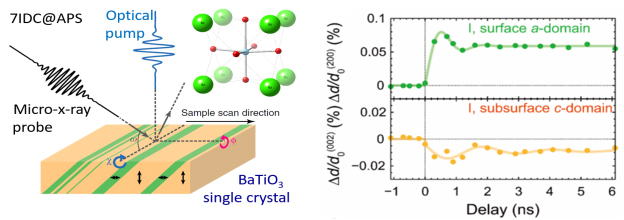
A team of researchers has made an important advance in broadening our understanding of light-induced mesoscale dynamics using the U.S. Department of Energy’s Advanced Photon Source (APS) at Argonne National Laboratory. Time-resolved x-ray diffraction microscopy, aided by a newly developed dynamical phase-field method (DPFM) , revealed how lattice waves can be excited by light pulses and the resulting local structural changes among mesoscopic domains in ferroelectrics, a widely utilized material for sensors, nanoscale positioners, and information storage devices.
Light interaction with matter offers a new way of controlling material properties by harnessing energy transport and conversion in functional materials without contact on ultrafast time scales. However, the desired dynamical control is complicated by the inhomogeneous response of real materials. The ultrafast dynamics depend not only on the intrinsic properties of the compound but also, strongly, on mesoscale structures such as surfaces, domains, interfaces, and defects that govern the coupling between various degrees of freedom.
Rich mesoscale phenomena inspire new functions but pose a great challenge to characterize and understand their fundamental processes in the time domain.
The researchers from The Pennsylvania State University and Argonne National Laboratory shone ultrafast laser pulses on a prototypical ferroelectric single crystal, BaTiO3. Due to absorption of the light, electrons are liberated from bonding states and start to move within a block of the material — a ferroelectric domain — whose lengths are on the order of a micrometer. These free charge carriers can experience very different local forces that pull them in certain directions depending on which domain they occupy.
As a result, the lattice start to respond to light-activated charge carriers on ultrafast time scales. To capture these local dynamics that occur on micrometer length and sub-nanosecond time scales, a focused x-ray beam from the X-ray Science Division 7-ID-C x-ray beamline at the APS, an Office of Science user facility at Argonne, was used to probe within and across domains following optical excitation, with the lattice dynamics manifesting itself as the change of diffraction intensity from the probing x-ray beam. The local structural dynamics, including oscillatory lattice spacing and rotation at gigahertz frequency in individual domains, can be clearly resolved.
Understanding such complex behavior without modeling tools that account for spatial complexity and short time scales is an outstanding challenge. The authors have newly developed a dynamical phase-field method (DPFM) which was used to successfully predict these rich structural dynamics. This demonstration of the ability to reveal mesoscopic structural changes opens up new opportunities for understanding mesoscale phenomena and optimizing the functionalities of technologically important materials.
The continuous innovation of x-ray instruments at the APS has allowed users to enter a new spatiotemporal regime to solve challenging problems that could not previously be answered. With the APS Upgrade, higher spatial resolution and better signal-to-noise ratio will further empower these cutting-edge x-ray research tools for meeting mesoscopic energy challenges.
See: Hirofumi Akamatsu1, Yakun Yuan1, Vladimir Stoica1,2, Greg Stone1, Tiannan Yang1, Zijian Hong1, Shiming Lei1, Yi Zhu2, Ryan C. Haislmaier1, John W. Freeland2, Long-Qing Chen1, Haidan Wen2, and Venkatraman Gopalan1*, “Light-activated Gigahertz Ferroelectric Domain Dynamics,” Phys. Rev. Lett. 120, 096101 (2018). DOI: 10.1103/PhysRevLett.120.096101
Author affiliations: 1The Pennsylvania State University, 2Argonne National Laboratory
Correspondence: *[email protected]
H.A., Y.Y., V.S., H.W., J.F., and V.G. were supported by the U.S Department of Energy (DOE) Office of Science-Basic Energy Sciences, under grant No. DE- SC0012375, for the ultrafast XRD microscopy and ultra- fast optical pump SHG probe work. G.S., S.L., R.H., and Z.H. were supported by National Science Foundation (NSF) grant NO. DMR- 1420620 for the XRD data analysis, PFM measurements, UV-vis absorption measurements, and DPFM. T.Y. and L.Q.C. acknowledge the support by NSF under grant No. DMR-1410714 for the DPFM work. This research used resources of the Advanced Photon Source, a U.S. DOE Office of Science User Facility operated for the DOE Office of Science by Argonne National Laboratory, supported by Contract No. DE-AC02- 06CH11357.
Argonne National Laboratory seeks solutions to pressing national problems in science and technology. The nation's first national laboratory, Argonne conducts leading-edge basic and applied scientific research in virtually every scientific discipline. Argonne researchers work closely with researchers from hundreds of companies, universities, and federal, state and municipal agencies to help them solve their specific problems, advance America's scientific leadership and prepare the nation for a better future. With employees from more than 60 nations, Argonne is managed by UChicago Argonne, LLC for the U.S. Department of Energy's Office of Science.
The U.S. Department of Energy's Office of Science is the single largest supporter of basic research in the physical sciences in the United States and is working to address some of the most pressing challenges of our time. For more information, visit the Office of Science website.
